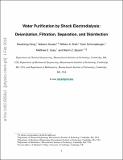| dc.contributor.author | Schlumpberger, Sven | |
| dc.contributor.author | Deng, Daosheng | |
| dc.contributor.author | Aouad, Wassim | |
| dc.contributor.author | Braff, William | |
| dc.contributor.author | Suss, Matthew | |
| dc.contributor.author | Bazant, Martin Z | |
| dc.date.accessioned | 2017-05-19T19:56:04Z | |
| dc.date.available | 2017-05-19T19:56:04Z | |
| dc.date.issued | 2014-11 | |
| dc.date.submitted | 2014-11 | |
| dc.identifier.issn | 0011-9164 | |
| dc.identifier.issn | 1873-4464 | |
| dc.identifier.uri | http://hdl.handle.net/1721.1/109234 | |
| dc.description.abstract | The development of energy and infrastructure efficient water purification systems is among the most critical engineering challenges facing our society. Water purification is often a multi-step process involving filtration, desalination, and disinfection of a feedstream. Shock electrodialysis (shock ED) is a newly developed technique for water desalination, leveraging the formation of ion concentration polarization (ICP) zones and deionization shock waves in microscale pores near to an ion selective element. While shock ED has been demonstrated as an effective water desalination tool, we here present evidence of other simultaneous functionalities. We show that shock ED can thoroughly filter micron-scale particles and aggregates of nanoparticles present in the feedwater. We also demonstrate that shock ED can enable disinfection of feedwaters, as approximately 99% of viable bacteria (here Escherichia coli) in the inflow were killed or removed by our prototype. Shock ED also separates positive from negative particles, contrary to claims that ICP acts as a virtual barrier for all charged particles. By combining these functionalities (filtration, separation and disinfection) with deionization, shock ED has the potential to enable highly compact and efficient water purification systems. | en_US |
| dc.language.iso | en_US | |
| dc.publisher | Elsevier | en_US |
| dc.relation.isversionof | http://dx.doi.org/10.1016/j.desal.2014.11.011 | en_US |
| dc.rights | Creative Commons Attribution-NonCommercial-NoDerivs License | en_US |
| dc.rights.uri | http://creativecommons.org/licenses/by-nc-nd/4.0/ | en_US |
| dc.source | arXiv | en_US |
| dc.title | Water purification by shock electrodialysis: Deionization, filtration, separation, and disinfection | en_US |
| dc.type | Article | en_US |
| dc.identifier.citation | Deng, Daosheng; Aouad, Wassim; Braff, William A.; Schlumpberger, Sven; Suss, Matthew E. and Bazant, Martin Z. “Water Purification by Shock Electrodialysis: Deionization, Filtration, Separation, and Disinfection.” Desalination 357 (February 2015): 77–83 © 2014 Elsevier B.V. | en_US |
| dc.contributor.department | Massachusetts Institute of Technology. Department of Chemical Engineering | en_US |
| dc.contributor.department | Massachusetts Institute of Technology. Department of Mathematics | en_US |
| dc.contributor.department | Massachusetts Institute of Technology. Department of Mechanical Engineering | en_US |
| dc.contributor.mitauthor | Deng, Daosheng | |
| dc.contributor.mitauthor | Aouad, Wassim | |
| dc.contributor.mitauthor | Braff, William | |
| dc.contributor.mitauthor | Suss, Matthew | |
| dc.contributor.mitauthor | Bazant, Martin Z | |
| dc.relation.journal | Desalination | en_US |
| dc.eprint.version | Original manuscript | en_US |
| dc.type.uri | http://purl.org/eprint/type/JournalArticle | en_US |
| eprint.status | http://purl.org/eprint/status/NonPeerReviewed | en_US |
| dspace.orderedauthors | Deng, Daosheng; Aouad, Wassim; Braff, William A.; Schlumpberger, Sven; Suss, Matthew E.; Bazant, Martin Z. | en_US |
| dspace.embargo.terms | N | en_US |
| dc.identifier.orcid | https://orcid.org/0000-0001-9529-2912 | |
| mit.license | PUBLISHER_CC | en_US |
| mit.metadata.status | Complete | |
